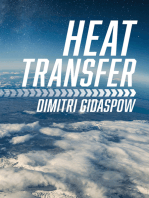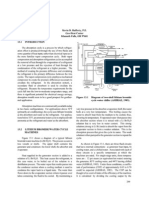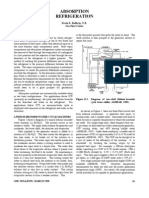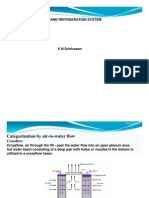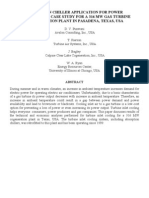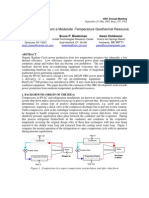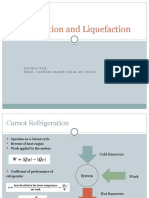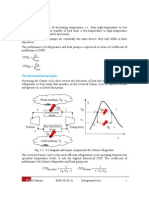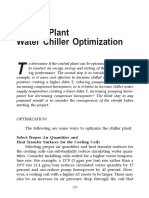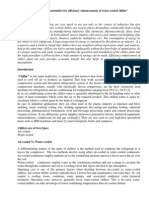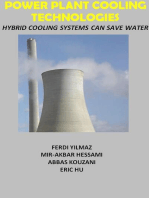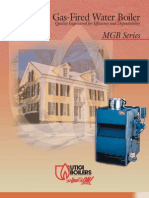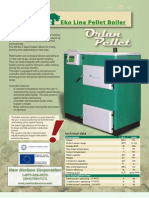Absorption Chillers
Absorption Chillers
Uploaded by
sanastasCopyright:
Available Formats
Absorption Chillers
Absorption Chillers
Uploaded by
sanastasCopyright
Available Formats
Share this document
Did you find this document useful?
Is this content inappropriate?
Copyright:
Available Formats
Absorption Chillers
Absorption Chillers
Uploaded by
sanastasCopyright:
Available Formats
CHAPTER 13
ABSORPTION
REFRIGERATION
Kevin D. Rafferty, P.E.
Geo-Heat Center
Klamath Falls, OR 97601
13.1 INTRODUCTION
The absorption cycle is a process by which refriger-
ation effect is produced through the use of two fluids and
some quantity of heat input, rather than electrical input as in
the more familiar vapor compression cycle. Both vapor
compression and absorption refrigeration cycles accomplish
the removal of heat through the evaporation of a refrigerant
at a low pressure and the rejection of heat through the
condensation of the refrigerant at a higher pressure. The
method of creating the pressure difference and circulating
the refrigerant is the primary difference between the two
cycles. The vapor compression cycle employs a mechanical
compressor to create the pressure differences necessary to
circulate the refrigerant. In the absorption system, a
secondary fluid or absorbent is used to circulate the
refrigerant. Because the temperature requirements for the
cycle fall into the low-to-moderate temperature range, and
there is significant potential for electrical energy savings,
absorption would seem to be a good prospect for geother-
mal application.
Absorption machines are commercially available today
in two basic configurations. For applications above 32
o
F
(primarily air conditioning), the cycle uses lithium bromide
as the absorbent and water as the refrigerant. For applica-
tions below 32
o
F, an ammonia/water cycle is employed with
ammonia as the refrigerant and water as the absorbent.
13.2 LITHIUM BROMIDE/WATER CYCLE
MACHINES
Figure 13.1 shows a diagram of a typical lithium
bromide/water machine (Li Br/H
2
O). The process occurs in
two vessels or shells. The upper shell contains the
generator and condenser; the lower shell, the absorber and
evaporator.
Heat supplied in the generator section is added to a
solution of Li Br/H
2
O. This heat causes the refrigerant, in
this case water, to be boiled out of the solution in a
distillation process. The water vapor that results passes into
the condenser section where a cooling medium is used to
condense the vapor back to a liquid state. The water then
flows down to the evaporator section where it passes over
tubes containing the fluid to be cooled. By maintaining a
Figure 13.1 Diagram of two-shell lithium bromide
cycle water chiller (ASHRAE, 1983).
very low pressure in the absorber-evaporator shell, the water
boils at a very low temperature. This boiling causes the
water to absorb heat from the medium to be cooled, thus,
lowering its temperature. Evaporated water then passes into
the absorber section where it is mixed with a Li Br/H
2
O
solution that is very low in water content. This strong
solution (strong in Li Br) tends to absorb the vapor from the
evaporator section to form a weaker solution. This is the
absorption process that gives the cycle its name. The weak
solution is then pumped to the generator section to repeat the
cycle.
As shown in Figure 13.1, there are three fluid circuits
that have external connections: a) generator heat input, b)
cooling water, and c) chilled water. Associated with each of
these circuits is a specific temperature at which the
machines are rated. For single-stage units, these tempera-
tures are : 12 psi steam (or equivalent hot water) entering
the generator, 85
o
F cooling water, and 44
o
F leaving chilled
water (ASHRAE, 1983). Under these conditions, a coeffic-
ient of performance (COP) of approximately 0.65 to 0.70
could be expected (ASHRAE, 1983). The COP can be
thought of as a sort of index of the efficiency of the machine.
It is calculated by dividing the cooling output by the
299
required heat input. For example, a 500-ton absorption
chiller operating at a COP of 0.70 would require: (500 x
12,000 Btu/h) divided by 0.70 = 8,571,429 Btu/h heat
input. This heat input suggests a flow of 9,022 lbs/h of 12
psi steam, or 1,008 gpm of 240
o
F water with a 17
o
F T.
Two-stage machines with significantly higher COPs
are available (ASHRAE, 1983). However, temperature
requirements for these are well into the power generation
temperature range (350
o
F). As a result, two-stage machines
would probably not be applied to geothermal applications.
13.3 PERFORMANCE
Based on equations that have been developed
(Christen, 1977) to describe the performance of a single-
stage absorption machine, Figure 13.2 shows the effect on
COP and capacity (cooling output) versus input hot-water
temperature. Entering hot water temperatures of less than
220
o
F result in substantial reduction in equipment capacity.
The reason for the steep drop off in capacity with
temperature is related to the nature of the heat input to the
absorption cycle. In the generator, heat input causes boiling
to occur in the absorbent/refrigerant mixture. Because the
pressure is fairly constant in the generator, this fixes the
boiling temperature. As a result, a reduction in the en-
tering hot water temperature causes a reduction in the
temperature difference between the hot fluid and the boiling
mixture. Because heat transfer varies directly with temper-
ature difference, there is a nearly linear drop off in absorp-
tion refrigeration capacity with entering hot water tempera-
ture. In the past few years, one manufacturer (Yazaki,
undated) has modified small capacity units (2 to 10 ton) for
increased performance at lower inlet temperature. How-
ever, low-temperature modified machines are not yet avail-
able in large outputs, which would be applicable to
institutional- and industrial-type projects. Although COP
and capacity are also affected by other variables such as
condenser and chilled water temperatures and flow rates,
generator heat input conditions have the largest impact on
performance. This is a particularly important consideration
with regard to geothermal applications.
Because many geothermal resources in the 240
o
F and
above temperature range are being investigated for power
generation using organic Rankine cycle (ORC) schemes, it
is likely that space conditioning applications would see
temperatures below this value. As a result, chillers
operating in the 180 to 230
o
F range would (according to
Figure 13.2) have to be (depending on resource tempera-
ture) between 400 and 20% oversized respectively for a
particular application. This would tend to increase capital
cost and decrease payback when compared to a conven-
tional system.
An additional increase in capital cost would arise from
the larger cooling tower costs that result from the low COP
of absorption equipment. The COP of singe effect equip-
ment is approximately 0.7. The COP of a vapor compres-
sion machine under the same conditions may be 3.0 or
higher. As a result, for each unit of refrigeration, a vapor
compression system would have to reject 1.33 units of heat
at the cooling tower. For an absorption system, at a COP of
0.7, 2.43 units of heat must be rejected at the cooling tower.
This results in a significant cost penalty for the absorption
system with regard to the cooling tower and accessories.
Figure 13.2 Capacity of a lithium bromide absorption chiller (Christen, 1977).
300
0
100
200
300
400
500
600
I
n
s
t
a
l
l
e
d
C
o
s
t
i
n
$
*
1
0
0
0
0 200 400 600 800 1000
Capacity in Tons
Abs chlr
Elec chlr
Abs twr
Elec twr
In order to maintain good heat transfer in the generator
section, only small Ts can be tolerated in the hot water
flow stream. This is a result of the fact that the machines
were originally designed for steam input to the generator.
Heat transfer from the condensing steam is a constant
temperature process. As a result, in order to have equal
performance, the entering hot water temperature would have
to be above the saturated temperature corresponding to the
inlet steam pressure at rated conditions. This is to allow for
some T in the hot water flow circuit. In boiler coupled
operation, this is of little consequence to operating cost.
However, because T directly affects flow rate, and thus
pumping energy, this is a major consideration in geothermal
applications.
For example, assuming a COP of 0.54 and 15
o
F T on
the geothermal fluid, 250 ft pump head and 65% wire-to-
water efficiency at the well pump, approximately 0.20 kW/t
pumping power would be required. This compares to
approximately 0.50 - 0.60 kW/t for a large centrifugal
machine (compressor consumption only).
The small T and high flow rates also point out
another consideration with regard to absorption chiller use
in space conditioning applications. Assume a geothermal
system is to be designed for heating and cooling a new
building. Because the heating system can be designed for
rather large Ts in comparison to the chiller, the
incremental cost of the absorption approach would have to
include the higher well and/or pump costs to accommodate
its requirements. A second approach would be to design the
well for space heating requirements and use a smaller
absorption machine for base load duty. In this approach, a
second electric chiller would be used for peaking. In either
case, capital cost would be increased.
13.4 LARGE TONNAGE EQUIPMENT COSTS
Figure 13.3 presents some more general cost
information on large tonnage (>100 tons) cooling equipment
for space conditioning applications. The plot shows the
installed costs for both absorption chillers (Abs. chlr.),
centrifugal chillers (Elec. chlr.), and auxilliary condenser
equipment (cooling tower, cooling water pumps and cooling
water piping) for both absorption chillers (Abs. twr.) And
centrifugal chillers (Elec. twr.). As shown, both the chiller
itself and its auxilliary condenser equipment costs are much
higher for the absorption design than for electric-driven
chillers. These are the primary capital cost differences that
a geothermal operation would have to compensate for in
savings.
13.5 SMALL TONNAGE EQUIPMENT
To our knowledge, there is only one company (Yazaki,
undated) currently manufacturing small tonnage (<20
tons) lithium bromide refrigeration equipment. This firm,
located in Japan, produces equipment primarily for solar
applications. Currently, units are available in 1.3, 2, 3, 5,
7.5, and 10 ton capacities. These units can be manifolded
together to provide capacities of up to 50 tons.
Because the units are water cooled chillers, they
require considerably more mechanical equipment for a
given capacity than the conventional electric vapor
compression equipment usually applied in this size range.
In addition to the absorption chiller itself, a cooling tower is
required. The cooling tower, which is installed outside,
requires interconnecting piping and a circulation pump.
Because the absorption machine produces chilled water, a
cooling coil and fan are required to deliver the cooling
Figure 13.3 Chiller and auxiliary equipment costs - electric and absorption (Means, 1996).
301
capacity to the space. Insulated piping is required to con-
nect the machine to the cooling coil. Another circulating
pump is required for the chilled water circuit. Finally, hot
water must be supplied to the absorption machine. This
requires a third piping loop.
In order to evaluate the economic merit of small
absorption equipment compared to conventional electric
cooling, Figure 13.4 was developed. This plot compares
the savings achieved through the use of the absorption
equipment to its incremental capital costs over a
conventional cooling system. Specifically, the figure plots
cost of electricity against simple payback in years for the
five different size units. In each case, the annual electric
cost savings of the absorption system (at 2,000 full load
hours per year) is compared to the incremental capital cost
of the system to arrive at a simple payback value. The
conventional system to which absorption is compared in this
case is a rooftop package unit. This is the least expensive
conventional system available. A comparison of the
absorption approach to more sophisticated cooling systems
(VAV, 4-pipe chilled water, etc.) would yield much more
attractive payback periods.
The plot is based on the availability of geothermal fluid
of sufficient temperature to allow operation at rated capacity
(190
o
F or above). In addition, other than piping, no costs
for geothermal well or pumping are incorporated. Only
cooling equipment related costs are considered. As a result,
the payback values in Figure 13.4 are valid only for a
situation in which a geothermal resource has already been
developed for some other purpose (space heating and
aquaculture), and the only decision at hand is that of
choosing between electric and absorption cooling options.
Figure 13.4 also shows that the economics of small
tonnage absorption cooling are attractive only in cases of 5
to 10 ton capacity requirements and more than $0.10 kW/h
electrical costs. Figure 13.4 is based on an annual cooling
requirement of 2,000 full load hours per year. This is on the
upper end of requirements for most geographical areas. To
adjust for other annual cooling requirements, simply
multiply the simple payback from Figure 13.4 by actual full
load hours and divide by 2,000.
The performance of the absorption cooling machine
was based on nominal conditions in order to develop Figure
13.4. It should be noted that, as with the larger machines,
performance is heavily dependent upon entering hot water
temperature and entering cooling water temperature.
Ratings are based on 190
o
F entering hot water, 85
o
F ent-
ering cooling water and 48
o
F leaving chilled water. Flow
rates for all three loops are based upon a 9
o
F T.
Figure 13.4 Simple payback on small absorption equipment compared to conventional rooftop equipment.
302
Figure 13.5 Small tonnage absorption equipment performance.
Figure 13.5 illustrates the effect of entering hot water
temperature and entering cooling water temperature on
small machine performance. At entering hot water
temperatures of less than 180
o
F, substantial derating is
necessary. For preliminary evaluation, the 85
o
F cooling
water curve should be employed.
13.6 COMMERCIAL REFRIGERATION
Most commercial and industrial refrigeration appli-
cations involve process temperatures of less than 32
o
F and
many are 0
o
F. As a result, the lithium bromide/water cycle
is no longer able to meet the requirements, because water
is used for the refrigerant. As a result, a fluid which is not
subject to freezing at these temperatures is required. The
most common type of absorption cycle employed for these
applications is the water/ammonia cycle. In this case, water
is the absorbent and ammonia is the refrigerant.
Use of water/ammonia equipment in conjunction with
geothermal resources for commercial refrigeration applica-
tions is influenced by some of the same considerations as
space cooling applications. Figure 13.5 illustrates the most
important of these. As refrigeration temperature is re-
duced, the required hot water input temperature is in-
creased. Because most commercial and industrial refrige-
ration applications occur at temperatures below 32
o
F,
required heat input temperatures must be at least 230
o
F. It
should also be remembered that the required evaporation
temperature is 10 to 15
o
F below the process temperature.
For example, for a +20
o
F cold storage application, a 5
o
F
evaporation temperature would be required.
Figure 13.6 suggests a minimum hot water temperature
of 275
o
F would be required. There is not a large number of
geothermal resources in this temperature range. For geo-
thermal resources that produce temperatures in this range,
it is likely that small scale power generation would be com-
peting consideration unless cascaded uses are employed.
Figure 13.7 indicates another consideration for re-
frigeration applications. The COP for most applications is
likely to be less than 0.55. As a result, hot water flow
requirements are substantial. In addition, the cooling tower
requirements, as discussed above, are much larger than for
equivalently sized vapor compression equipment.
13.7 CURRENT ABSORPTION RESEARCH
Recent work at the Lawrence Berkeley Laboratory
(LBL)(Wahlig, 1984) has resulted in significantly improved
absorption cycle performance. Researchers at LBL,
working to improve absorption cycle performance for solar
application, have developed two advanced versions of the
ammonia/water machine. Ammonia/water was chosen as
the working fluid pair in order to allow the use of an air-
cooled condenser for potential heat pump operation.
303
Figure 13.6 Required resource temperatures for ammonia/water absorption equipment (Hirai, 1982).
Figure 13.7 The COP for ammonia/water absorption equipment in refrigeration applications (Hirai, 1982).
304
Figure 13.8 Ammonia/water single and double effect regenerative cycle performance (Wahlig, 1984).
The two cycles that have been developed are designed
1R and 2R for single effect regenerative cycle and double
effect regenerative cycle, respectively. As shown in Figure
13.8, these two cycles show substantially higher COP, over
a much broader range of generator input temperatures than
the conventional lithium/bromide cycles. The superior
performance is achieved by operating the chiller input stage
at constant temperature, rather than constant pressure as in
conventional systems. This has the effect of reducing the
thermodynamic irreversibilities in the absorption cycle
(Wahlig, 1984).
It is not known to what extent this technology has been
incorporated by the major manufacturers of indirect fired
absorption equipment.
13.8 MATERIALS
The generator section is the only portion of the
absorption machine that is likely to be exposed to the
geothermal fluid. In this section, the heating medium is
passed through a tube bundle to provide heat to the
refrigerant/absorbent mixture located in the shell.
The generator tube bundle is generally constructed of
copper or a copper alloy (90/10 cupro nickel). These al-
loys, as discussed in Chapter 8, are not compatible with
most geothermal resources, particularly if hydrogen
sulphide (H
2
S), ammonia (NH
3
) or oxygen are present. Be-
cause most resources contain some or all of these
dissolved gases, exposure of standard construction chillers
to these fluids is not recommended. Two available options
are:
1. Special order chiller with corrosion resistant tubes.
2. An isolation heat exchanger and clean water loop.
Conversations with at least one major large tonnage
absorption machine manufacturer indicate that the first
option may be the most cost effective (Todd, 1987).
Although a 316 stainless steel tube would appear to be the
most cost effective, the manufacturer suggest the use of
titanium. Because titanium tubes are more generally
available in the enhanced surface configurations necessary
for this application, their cost is very competitive with the
stainless steel tubes. In addition, the use of unenhanced
stainless steel tubes would, according to the manufacturer,
result in a large de-rating of the chiller because of less
effective heat transfer.
The incremental capital cost for this type of
construction (titanium generator tubes) would amount to
approximately 10 to 15% of the basic machine cost. In most
cases, this would be far less than the cost associated with
the heat exchanger, circulating pump, piping, and controls
necessary for an isolation loop. An additional advantage is
that the alternate generator construction avoids the losses
associated with the heat exchanger.
305
13.9 CONCLUSION
In conclusion, it is necessary to evaluate the following
factors when considering a geothermal/absorption cooling
application for space conditioning.
Resource temperature
Substantial derating factors must be applied to
equipment at temperatures less than 220
o
F. Very high
resource temperatures or two-stage are required for
low-temperature refrigeration.
Absorption machine hot water requirements
compared to space heating flow requirements
Incremental well and pumping costs should be applied
to the absorption machine.
Refrigeration capacity required
Larger machines have lower incremental capital costs
on a $/ton basis. Coupled with the larger displaced
energy, this result in a more positive economic picture.
Annual cooling load for space conditioning, in full
load hours or for process cooling, in terms of load
factor
Obviously higher utilization of the equipment results in
more rapid payout.
Pumping power for resources with unusually low
static water levels or drawdowns
Pumping power may approach 50% of high efficiency
electric chiller consumption.
306
Utility rates
As with any conservation project, high utility rates for
both consumption and demand result in better system
economics.
REFERENCES
American Society of Heating, Refrigeration and Air
Conditioning Engineers, 1983. "1983 Handbook of
Fundamentals," ASHRAE, Atlanta, GA, pp. 14.1-14.8.
Christen, J. E., 1977. "Central Cooling - Absorptive Chill-
ers," Oak Ridge National Laboratory, Oak Ridge TN.
Hirai, W. A., 1982. "Feasibility Study of an Ice Making
and Cold Storage Facility Using Geothermal Waste
Heat," Geo-Heat Center, Klamath Falls, OR.
Means, R. S., 1985. "1985 Means Mechanical Cost Data,"
R. S. Means, Inc., Kingston, MA.
Todd, M., Sales Engineer, 1987. Personal communica-
tion. Airefco Inc., Portland, OR.
Wahlig, M., 1984. Lawrence Berkeley Laboratory. Per-
sonal communication with Gene Culver, Geo-Heat
Center.
Yazaki Corporation, undated. Yazaki Gas & Solar Air
Conditioning Equipment - Cat. No. 15.3 AME, Yazaki
Corporation, Tokyo, Japan.
You might also like
- CoolingDocument26 pagesCoolingShahrukh AnsariNo ratings yet
- 4 Point Inspection FormDocument3 pages4 Point Inspection Formsendmattanemail4346No ratings yet
- Jenbacher: 1100-0112 Installation of GE Jenbacher UnitsDocument9 pagesJenbacher: 1100-0112 Installation of GE Jenbacher UnitsArîfNo ratings yet
- Fan Coil Unit: YPHBC 200 1600 OptionalDocument1 pageFan Coil Unit: YPHBC 200 1600 Optionalcm08909No ratings yet
- Erie 2401S Installation Service ManualDocument44 pagesErie 2401S Installation Service ManualGreg Reyneke100% (1)
- Absorption Refrigeration: Kevin D. Rafferty, P.E. Geo-Heat Center Klamath Falls, OR 97601Document8 pagesAbsorption Refrigeration: Kevin D. Rafferty, P.E. Geo-Heat Center Klamath Falls, OR 97601nadam54321No ratings yet
- Ammonia AbsorptionDocument8 pagesAmmonia AbsorptiondandymeNo ratings yet
- Absorption Refrigeration: Kevin D. Rafferty, P.E. Geo-Heat CenterDocument4 pagesAbsorption Refrigeration: Kevin D. Rafferty, P.E. Geo-Heat CenterRichard WeimerNo ratings yet
- F.L.lansing - Computer Modeling of LiBr - VAR SystemDocument11 pagesF.L.lansing - Computer Modeling of LiBr - VAR SystemRana Abdul RehmanNo ratings yet
- Different Refrigeration systems-AKMDocument23 pagesDifferent Refrigeration systems-AKMRafia RizwanaNo ratings yet
- Cooling Tower1Document66 pagesCooling Tower1Er Bali Pandhare100% (1)
- Cooling Tower Water CalculationsDocument11 pagesCooling Tower Water CalculationsShesadri ChakrabartyNo ratings yet
- Optimizing Chiller Tower Systems PDFDocument8 pagesOptimizing Chiller Tower Systems PDFasl91100% (1)
- Cooling Tower PDFDocument30 pagesCooling Tower PDFcynaidu100% (1)
- Thermal Performance of A Direct Expansion Solar-Assisted Heat PumpDocument8 pagesThermal Performance of A Direct Expansion Solar-Assisted Heat PumpJessica SilvaNo ratings yet
- COOLINGDocument3 pagesCOOLINGAbhishek Roy ChoudhuryNo ratings yet
- Minimizing Energy Costs With Free Cooling: Technical Resources Technical ResourcesDocument12 pagesMinimizing Energy Costs With Free Cooling: Technical Resources Technical ResourcesAnonymous 7z6OzoNo ratings yet
- ME 441-NotesDocument4 pagesME 441-NotesAshish ManwarNo ratings yet
- Refrigeration and LiquefactionDocument51 pagesRefrigeration and LiquefactionAlbert ShesmanNo ratings yet
- Comb CycleDocument13 pagesComb Cyclerain55555No ratings yet
- Shopmillingmsme: Steam Jet Refrigeration SystemDocument7 pagesShopmillingmsme: Steam Jet Refrigeration SystembbaytlNo ratings yet
- Steam Jet Refrigeration SystemDocument7 pagesSteam Jet Refrigeration SystembbaytlNo ratings yet
- HVAC Cooling WaterDocument54 pagesHVAC Cooling WaterShiyamraj Thamodharan100% (1)
- Shopmillingmsme: Steam Jet Refrigeration SystemDocument7 pagesShopmillingmsme: Steam Jet Refrigeration SystembbaytlNo ratings yet
- Steam Jet Refrigeration SystemDocument7 pagesSteam Jet Refrigeration SystembbaytlNo ratings yet
- Shopmillingmsme: Steam Jet Refrigeration SystemDocument7 pagesShopmillingmsme: Steam Jet Refrigeration SystembbaytlNo ratings yet
- Steam Jet Refrigeration SystemDocument7 pagesSteam Jet Refrigeration SystembbaytlNo ratings yet
- 22 Msn20212208 2021 Rp4b 13 Pertemuan Ke 13 Refrigeration SystemDocument5 pages22 Msn20212208 2021 Rp4b 13 Pertemuan Ke 13 Refrigeration SystemAnd TransNo ratings yet
- Shopmillingmsme: Steam Jet Refrigeration SystemDocument7 pagesShopmillingmsme: Steam Jet Refrigeration SystembbaytlNo ratings yet
- Diesel Engineering HandbookDocument14 pagesDiesel Engineering Handbookmartin.ruben100% (1)
- Calpine PowerDocument12 pagesCalpine PowermasoodfawazNo ratings yet
- Chapter 4: The First Law of Thermodynamics For Control Volumes B) Steam Power PlantsDocument8 pagesChapter 4: The First Law of Thermodynamics For Control Volumes B) Steam Power PlantsTHEOPHILUS ATO FLETCHERNo ratings yet
- Al 3419231934Document12 pagesAl 3419231934IJMERNo ratings yet
- Carnot Refrigeration CycleDocument11 pagesCarnot Refrigeration CycleZaimNo ratings yet
- REPORTDocument3 pagesREPORTEdrielleNo ratings yet
- Steam Jet Refrigeration SystemDocument7 pagesSteam Jet Refrigeration SystembbaytlNo ratings yet
- GT - Turbine Inlet CoolingDocument12 pagesGT - Turbine Inlet CoolingSharon Lambert100% (2)
- Heat Sink Considerations - ThermoelectricDocument2 pagesHeat Sink Considerations - ThermoelectricNaranLoganNo ratings yet
- Effectively Design ACHE'sDocument22 pagesEffectively Design ACHE'sSeshu Bulusu100% (1)
- Vapour Absorption Refrigeration SystemDocument4 pagesVapour Absorption Refrigeration SystemAmith KumarNo ratings yet
- Power Production From A Moderate - Temperature Geothermal ResourceDocument8 pagesPower Production From A Moderate - Temperature Geothermal ResourceSanjoy BasakNo ratings yet
- Refrigeration and Air ConditioningDocument9 pagesRefrigeration and Air ConditioningLuis Enrique Cervantes DominguezNo ratings yet
- Refrigeration CycleDocument12 pagesRefrigeration CycleNabankur Ray100% (1)
- Design of Commercial UnitsDocument5 pagesDesign of Commercial UnitsBruce LawNo ratings yet
- Refrigeration and Liquefaction: Instructor: Engr. Caressa Marie Frial-De JesusDocument22 pagesRefrigeration and Liquefaction: Instructor: Engr. Caressa Marie Frial-De JesusEmmanuel PlazaNo ratings yet
- Advantages and Disadvantages of Using Absorption Chillers ToDocument4 pagesAdvantages and Disadvantages of Using Absorption Chillers Toأحمد صلاح100% (1)
- Rentech Vol 2 05 JraDocument8 pagesRentech Vol 2 05 JraArman MalikNo ratings yet
- Air Cooler Design SheikoDocument22 pagesAir Cooler Design Sheikojayhuacat7743100% (1)
- Chiller Plant LectureDocument10 pagesChiller Plant LectureGrano PrabumuktiNo ratings yet
- Steam Jet Refrigeration System SeminarDocument16 pagesSteam Jet Refrigeration System SeminarAmit Prakash100% (2)
- Refrigeration CycleDocument8 pagesRefrigeration CycleMohamed HassanainNo ratings yet
- Ashrae D 9305 20021125Document7 pagesAshrae D 9305 20021125Gaye KanalNo ratings yet
- 3 Dk2831 - ch35 EvaporadoresDocument10 pages3 Dk2831 - ch35 EvaporadoresHarold Valle ReyesNo ratings yet
- Waste Heat Boiler Plate Heat ExchangersDocument8 pagesWaste Heat Boiler Plate Heat ExchangerskondusamyNo ratings yet
- Cooling TowerDocument28 pagesCooling TowerKangae Ilham100% (4)
- Marley Perfomance Cooling Tower CTII-01ADocument4 pagesMarley Perfomance Cooling Tower CTII-01ApiolinwallsNo ratings yet
- Central Plant Water Chiller Optimization 259Document2 pagesCentral Plant Water Chiller Optimization 259Rohit ShresthaNo ratings yet
- Exhaust Base Vam Tonnage CalculationDocument9 pagesExhaust Base Vam Tonnage CalculationMagical RiyaNo ratings yet
- A Seminar Report On Water Cooled ChillerDocument15 pagesA Seminar Report On Water Cooled ChillerSudip Sharma100% (4)
- Mechanics of the Household: A Course of Study Devoted to Domestic Machinery and Household Mechanical AppliancesFrom EverandMechanics of the Household: A Course of Study Devoted to Domestic Machinery and Household Mechanical AppliancesNo ratings yet
- Sustainable Energy Conversion for Electricity and Coproducts: Principles, Technologies, and EquipmentFrom EverandSustainable Energy Conversion for Electricity and Coproducts: Principles, Technologies, and EquipmentNo ratings yet
- ViiiDocument11 pagesViiisanastasNo ratings yet
- SIRIUS Motor Management and Control Devices: Wiring Diagrams 3UF70.0-1A00-0 Basic Unit 3UF7400-1AA00-0 Analog ModuleDocument1 pageSIRIUS Motor Management and Control Devices: Wiring Diagrams 3UF70.0-1A00-0 Basic Unit 3UF7400-1AA00-0 Analog ModulesanastasNo ratings yet
- 5SJ65106KS Datasheet enDocument2 pages5SJ65106KS Datasheet ensanastasNo ratings yet
- The Surge Protection Device (SPD) : From Electrical Installation GuideDocument7 pagesThe Surge Protection Device (SPD) : From Electrical Installation GuidesanastasNo ratings yet
- 5SJ65106KS Datasheet enDocument4 pages5SJ65106KS Datasheet ensanastasNo ratings yet
- CCTV Training Course-1Document10 pagesCCTV Training Course-1sanastasNo ratings yet
- 7SS50xx Catalog SIP2004 en SammelschienenDocument4 pages7SS50xx Catalog SIP2004 en SammelschienensanastasNo ratings yet
- Electrical Maintenance Training Equipment-GTEEDocument2 pagesElectrical Maintenance Training Equipment-GTEEsanastasNo ratings yet
- Filter Low Pass Butterworth Design MultisimDocument10 pagesFilter Low Pass Butterworth Design Multisimsanastas100% (1)
- B.Sc.E.E B.Sc.E.E.: D. Bar-Akiva Consulting Engineers (Israel) LTD Data CentersDocument7 pagesB.Sc.E.E B.Sc.E.E.: D. Bar-Akiva Consulting Engineers (Israel) LTD Data CenterssanastasNo ratings yet
- © by Tony Van RoonDocument24 pages© by Tony Van RoonBagavath Singh100% (1)
- Banister CarsenDocument220 pagesBanister CarsenArih FadiNo ratings yet
- 766-CBS1151V ManualDocument24 pages766-CBS1151V ManualJuan BermejoNo ratings yet
- Engineering Standard: IPS-E-CE-360Document18 pagesEngineering Standard: IPS-E-CE-360babakfun2000No ratings yet
- Sist en 12953 1 2012Document12 pagesSist en 12953 1 2012Nelu Gavriliuc100% (1)
- 100 Sustainable CitiesDocument164 pages100 Sustainable CitiesMozafar VeysipanahNo ratings yet
- AOSCA80000Document62 pagesAOSCA80000arunNo ratings yet
- Samyang PDFDocument186 pagesSamyang PDFDidin BaeNo ratings yet
- Bargarh Rice Mills OrissaDocument16 pagesBargarh Rice Mills OrissaBlazeDream Technologies Pvt LtdNo ratings yet
- User Manual Book: Gas Instant Water HeaterDocument20 pagesUser Manual Book: Gas Instant Water HeaterAriefNo ratings yet
- Sac - WacDocument4 pagesSac - WacAdyasa ChoudhuryNo ratings yet
- Steam Consumption of Heat Exchangers - International Site For Spirax Sarco (Calorifier)Document7 pagesSteam Consumption of Heat Exchangers - International Site For Spirax Sarco (Calorifier)Prak RemNo ratings yet
- Utica MGB Hot Water Gas Fired Boiler BrochureDocument4 pagesUtica MGB Hot Water Gas Fired Boiler Brochuree-ComfortUSANo ratings yet
- WebastoserviceDocument72 pagesWebastoserviceanasrl2006No ratings yet
- 236ecem ManualDocument15 pages236ecem ManualLa perrritaaaNo ratings yet
- OrlanPellet BrochureDocument2 pagesOrlanPellet Brochuree-ComfortUSANo ratings yet
- Assessment 3 BSBSUS511Document16 pagesAssessment 3 BSBSUS511raul.simelmannNo ratings yet
- Climaveneta A I CXW DatabookDocument72 pagesClimaveneta A I CXW DatabookGGMUCNo ratings yet
- Evo Duo Manual Us Lit91127us 05.2018Document67 pagesEvo Duo Manual Us Lit91127us 05.2018Ronal SolisNo ratings yet
- Geothermal Power Plant: Wesleyan University-Philippines Mabini Extension, Cabanatuan CityDocument10 pagesGeothermal Power Plant: Wesleyan University-Philippines Mabini Extension, Cabanatuan CityRoss Sonny CruzNo ratings yet
- Prospekt RS75-250 GBDocument8 pagesProspekt RS75-250 GBClaudio Andres Lagos GuerreroNo ratings yet
- Camp X Operators Manual 1Document38 pagesCamp X Operators Manual 1Jacob IgrejaNo ratings yet
- Heat Recovery AhuDocument28 pagesHeat Recovery AhuSameera Sri Viduranga100% (1)
- D-Fsc015en B 22mclsdc016 Adm Section b10 Link enDocument22 pagesD-Fsc015en B 22mclsdc016 Adm Section b10 Link enSirdavis SilvaNo ratings yet
- Honeywell: Micronik 200 ApplicationDocument80 pagesHoneywell: Micronik 200 Applicationvan_dall_2No ratings yet
- HVAC Brochure PDFDocument8 pagesHVAC Brochure PDFkollidrNo ratings yet
- Evacuated Flat Plate Collector PDFDocument2 pagesEvacuated Flat Plate Collector PDFMattNo ratings yet
